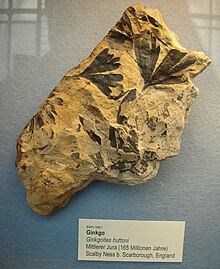Ginkgo huttonii
| Ginkgo huttonii Temporal range:
| |
|---|---|

| |
| Scientific classification | |
| Kingdom: | Plantae |
| Clade: | Tracheophytes |
| Clade: | Gymnospermae |
| Division: | Ginkgophyta |
| Class: | Ginkgoopsida |
| Order: | Ginkgoales |
| Family: | Ginkgoaceae |
| Genus: | Ginkgo |
| Species: | †G. huttonii
|
| Binomial name | |
| †Ginkgo huttonii (Sternb.) Heer
| |
Ginkgo huttonii is an extinct
broad-leaved, deciduous gymnosperm[1] bearing resemblance to the only living member of the Ginkgoaceae, Ginkgo biloba.[2]
Description
compression fossils of its leaves. Similar to other members of the Ginkgoites, the fossil leaves of G. huttonii are simple, four-lobed, and have dense, radially disposed venation.[3][2] G. huttonii fossil seeds are frequently found as well as at least a few fossilized male catkins.[4] G. huttonii wood has yet to be described but it is likely the plant was similar to the extant, G. biloba, with wood akin to that of modern-day conifers.[5]
Distribution
G. huttonii is heavily represented in the
Lower Jurassic through the Cretaceous.[7]
Discovery
G. Huttonii was discovered in the 1800s when excavation began throughout the Yorkshire formation. The fossil was first described by Oswald Heer.
References
- ^ Ernest M. Gifford (1998). "Ginkgophyte". Britannica. Encyclopaedia Britannica, Inc.
- ^ a b Villar de Seoane, Liliana (1997). "Comparative study between Ginkgoites tigrensisArchangelsky and Ginkgo bilobalinn. leaves" (PDF). Palaeobotanist. 46 (3): 1–12.
- .
- ^ Steur, Hans (March 1, 2020). "Ginkgo-like plants from Yorkshire". The Jurassic Flora of North Yorkshire. Retrieved June 10, 2020.
- ^ a b H.A. van Konijnenburg-van Cittert, Johanna (2008). "The Jurassic fossil plant record of the UK area". Proceedings of the Geologists' Association.
- S2CID 135123262.
- ^ "Ginkgoales: Fossil Record". Ginkgoales. UC Berkeley. 1997.
External links
